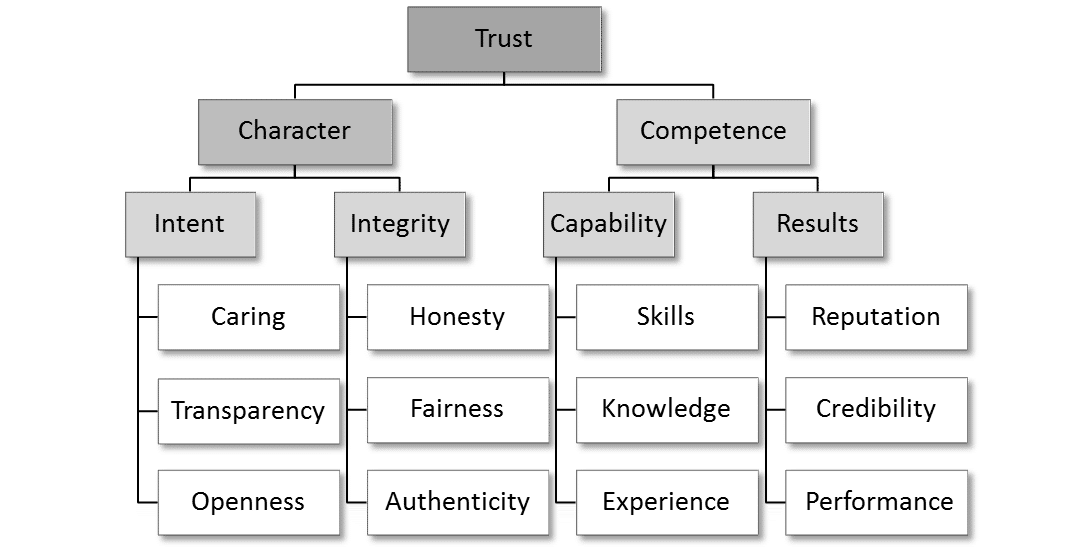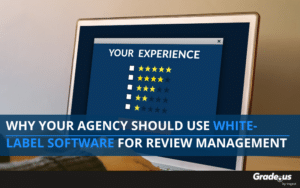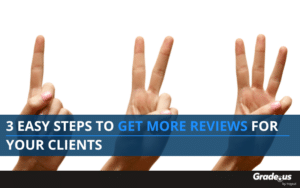"Are you helping or hurting me?"
It's the trust question your new client meetings need to answer. Clients are looking to see if you're under or over performing. At this point most sellers make a reasonable but incorrect assumption.
They assume their new clients trust them.
"I've already won this client," they tell themselves. “They’ve read hundreds of reviews from our happy customers. Of course they trust us!”
It's only partially true.
Your clients aren't completely sold on you yet
Am I suggesting that you don't have your client's trust?
Absolutely.
Because it's true. How's that possible?
New client relationships are incomplete. You’ve partially earned your client’s trust. At this point your sales process might have gone a little bit like this:
First, you give prospective clients social proof, authority and credibility boosters. Next, you meet with clients (before the contract is signed). You set expectations, outline deliverables, establish goals, metrics and KPIs.
Your client’s trust is growing incrementally.
But your clients still don't have what they need from you to establish a safe relationship that's built on trust. It’s a mistaken assumption service providers tend to make.
This sounds like a pretty harsh thing to say.
It also seems like an incredibly difficult thing to assess, right? I mean come on, how are you supposed to know whether a new client trusts you enough or not?
It's easy.
Stephen Covey outlined this in his book, The Speed of Trust. Trust, as it turns out, is a multi-faceted thing. It isn't as simple as saying the right things.
Trust takes time.
Trust holds people, teams, organizations and even countries together. Trust creates psychological safety, giving you the ability to share freely and openly with your clients.
New client meetings create safety...
If they're handled well.
They give you the opportunity to build a complete relationship with new clients. One that's based on each of the essential components of trust.
Trust components?
Covey divided trust into two main components, each with their own subcategories.
1. Character communicates who you are on the inside. It includes details like intent (caring, transparency and openness) and integrity (honesty, fairness and authenticity).
2. Competence communicates who you are on the outside. It focuses on capabilities (skills, knowledge, experience) and results (reputation, credibility and performance).
Covey outlines these components in the Trust Matrix.

When you sell clients on your product or service, you're ultimately asking them to take a risk. This matters because none of us can predict the future. A client who decides to take a chance with you is doing so without all of the facts they need.
Here's the problem.
Your client comes with baggage. They're mostly likely bringing:
- A lack of experience working with a firm like yours. These client may be overly cautious and filled with lots of questions.
- A poor experience, which could be a poor DIY experience or a bad experience with another firm.
New client meetings give you the chance to provide clients with the experiential and relational trust they need. Meeting with clients gives you the chance to show that you consistently overdeliver. Clients have questions, meetings give you the platform you need to answer.
Okay.
How often do you meet with your clients? Is there a set amount of meetings that's right for each client?
Absolutely.
But this introduces yet another problem. The amount of meetings you'll need is different for each client type and dependent on external variables.
How many types are there and how do you find them?
It’s fairly straight forward. You simply listen to your client’s words. Clients tend to use specific words, arranged in a particular order to get what they want. Identify the type of words they use and you identify the type of client you’re dealing with.
Here’s an important caveat.
You’ll want to ensure that the clients you target are a match for your agency. Working with the wrong client can create agency conflicts and limit campaign performance.
Let's take a look at our client types...
Client #1: The Hand holder
“Can you help me? Would you show me how to… What are the steps I’ll need to take to... If I need more help can I call you?”
The Hand holder asks questions, but they’re really requests for hands on help and support. They tend to be anxious and afraid, lost and confused. They don't have a firm grasp on the work you do, just that they need your help.
These clients are looking for an agency that's involved. In the beginning, they're needy, insecure and hesitant.
The more meetings you can provide the better. Initially, these clients can be exhausting to work with. They'll require a consistent stream of in-person, face-to-face, and digital communication.
Take the lead with these clients then, give them as much information as they can handle. Educate them on the ins and outs of their campaign. Show them which strategy and tactics are working (and why).
Expect to spend: 3 hours or more, per month, with these clients.
Scheduling this client requires several key ingredients - patience, agreeableness and time. If you decide to take this client type on, you’ll want to ensure you’re able to provide them with the right amount of hand holding.
These clients pay well but working with them can feel like a bottomless pit. They can drain your team's energy levels and morale pretty quickly so you’ll want to schedule these clients at the end of your work day.
Client #2: Curious questioner
These clients use phrases like “What about this? What happens if? How does Y work? What are the results from. What’s your policy on...”
This client is curious and full of questions.
They often masquerade as the Hand holder, but that's where the similarities end. This client is an analyst. They're looking for specific, detailed and logical answers to their questions. Provide them with satisfactory answers to their questions, and their trust in you grows. Fail to deliver, and their trust shrinks.
Their questions are thoughtful, focused and precise.
They’re looking for answers that explain.
Take the lead initially, then give them the chance to ask questions. Follow them down the rabbit hole as they work towards gaining a full and comprehensive understanding of their campaign.
Flexibility is key. If they have lots of questions, be willing to abandon your plans for the meeting. If they run out of questions to ask, make sure you have a meeting plan to fall back on. These detail oriented customers expect you to come prepared.
Expect to spend: 2 to 10 hours per month, initially, then a dramatic decrease once their questions are answered.
Scheduling this client requires a lot of upfront time. These clients are occasionally entitled. Some believe that paying for your service means you’re available at their beck and call. They’re easy to work with if you set firm scheduling boundaries ahead of time.
Give them your hours of availability upfront.
Work with them. Do your best to meet these clients halfway. When they’re out of questions they’re easier to manage.
Client #3: The Stoic director
This client is a commander.They use phrases like “just give me a back-of-the-envelope calculation, take care of it for me, get it done, when will it be ready" to communicate their disinterest.
Their approach is direct and upfront.
They're more interested in keeping their campaign or project on the right track and less interested in minutia. These clients want a high level view of the overall progress. They're not interested in the specifics and details.
Your job: manage minutia, get results
Their job: manage and direct, lead and enforce
Focus your meeting on the executive summary. Give your clients the broad strokes but be prepared to answer any questions they might have. As always, be succinct.
Expect to spend: 5 to 15 minutes per meeting. Expect scheduled and/or impromptu meetings as needed.
Scheduling this client requires a firm hand. It’s a good idea to approach these clients with the dates and times you have in mind. The Stoic director works to avoid meetings, but expects results (and reports) anyway.
Set strong boundaries with this client.
Require that they commit to a consistent date and time. Then, hold them accountable. Accountability and consequences give you the tools and resources you need to retain this disinterested client.
Client #4: Investment minded
“What’s the projected return on investment/ad spend? What’s the projected number of customers this will bring in? How long will I need to invest? How many reviews will this get me per month? What’s the bottom line impact on our conversion rates?”
This client wants just the facts.
They're avid utilitarians. They want the greatest amount of return possible for their investment - whether it's money, resources, people or time.
They're interested in concise meetings that quickly get to the point.
Give them the who, what, where, when, why and how immediately. Address the elephant in the room. Minimize small talk and idle chit chat. Keep rapport building to a minimum and whatever you do, don't waste their time.
Keep the meeting focused on results. Use investment oriented language - revenue, profit, return and conversion. Talk dollars and cents.
Expect to spend: 5 to 30 minutes per meeting, with multiple, impromptu meetings that are announced as needed.
Scheduling this client requires results. Don’t waste their time. Get to the point quickly. Be valuable, be brief, then be gone. Unless this client shows an interest, avoid small talk, rapport building or jokes.
The better you are at managing their time and resources, the more eager they’ll be to meet with you.
Here's the thing with these clients
I've given you rough estimates on the amount of time you'll need to spend with each client, but I haven't told you how often you'll need to meet.
There's a reason for that.
You'll need to decide what's best for your agency. Some agencies choose to minimize the amount of time they spend with clients one-on-one. Others emphasize customer service, choosing to give their clients the attention and care they need.
You'll need to determine what's best for you.
It's a good idea to (a.) set meeting minimums for your agency (b.) state how much you're willing to give should a client need more and (c.) decide how you'll handle clients who want more than you're willing to give.
Set these boundaries ahead of time.
Do what you can to identify the limits and boundaries for each client. Doing this upfront work means it's easier for you to avoid the predatory clients who are looking to take advantage of your business. It's important that you set the cadence and tone for your new client relationship.
Ignore it and clients will set the tone for you.
Use these client meetings to identify clients who, for whatever reason, aren’t a good fit for your agency. Maybe there’s a difference in communication/meeting style. Maybe you’ve identified a potential red flag.
Don’t sacrifice your agency’s processes, rubrics, or systems for a client. Stick to the meeting cadence and tone that works best for your agency.
Finally, expect your clients to change over time. The Hand holder becomes the Stoic director. The investment minded asks for hand holding. As your campaign changes, so will your clients.
Meet clients where they are.
Focus your time and attention on the details that matters most to them. Pay attention to the cues and signals your clients send. Then, do your very best to serve their needs.
Your clients aren't sold on you...
Yet.
"Are you helping or hurting me?" In the beginning, your clients aren't sure they have the answer. Clients want to see that you're over-performing. New client relationships are incomplete. Your clients don't have what they need to establish trust.
They've taken a risk.
New client meetings create safety. They offer peace of mind. They give you the chance to provide clients with the experiential and relational trust they need to feel safe and secure. The very same ingredients you need to win their loyalty.
New client meetings aren't a waste of time.
They're important tools you can use to give clients the help they desperately need.
About the Author
Andrew McDermott
Andrew McDermott is the co-founder of HooktoWin. He shows entrepreneurs how to attract and win new customers.









